Keepers of the Lights
Though lighthouses are no longer staffed by resident keepers in this day and age of automation, there are still dedicated professionals watching over them.
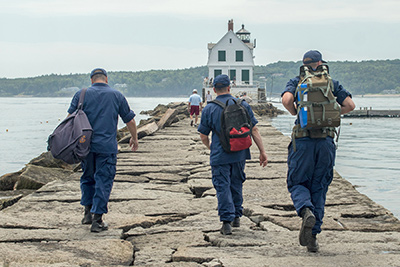
(Photo by Dominic Trapani)
When a mariner or landlubber sees a lighthouse “winking & blinking” at night – or hears a foghorn bellowing out its audible warning through a shroud of misty vapor, they can rest assure that the men and women of the United States Coast Guard are maintaining the same spirit of vigilance that the bygone keepers of the United States Lighthouse Service were renowned for.
Longtime lighthouse keeper and author Robert Thayer Sterling once said that the keeper of a light “must know his equipment and how to use it. His light, with its delicate mechanism, and his fog signals are instruments which must be kept going perfectly. A slight change in the warnings of a particular light might lead a ship to disaster instead of safety.”
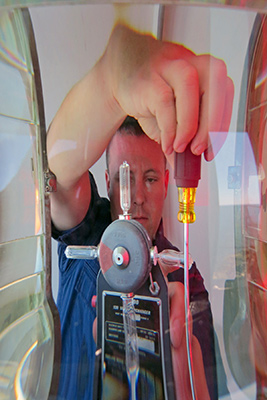
(Photo by Bob Trapani, Jr.)
Mr. Sterling penned these words during the 1930s, but as much as things change, they remain the same. Today, USCG lighthouse technicians adhere to the same type of focus and commitment when it comes to keeping 21st century lights and fog horns in tip-top shape.
Did you know that the Coast Guard is still “keeping a good light” at fifty-five historic lighthouses along the Maine coast from Kittery to Calais? They are also maintaining thirty-six fog horns at various Maine light stations. And this does not include minor lights, daybeacons and the vast number of buoys that work in concert with lighthouses as part of a larger aids to navigation system.
Instead of filling lamps with oil or kerosene, winding clockwork mechanisms, polishing brass or keeping a light station inspection-ready at all times like the old-time “Wickies,” the work of modern Coast Guard lighthouse technicians entails (in part) replenishing lamps, replacing lampchangers, flashers and daylight control units, keeping batteries filled with water, repairing drivers, oscillators and timer cards in fog horns and maintaining a plethora of other vital electronic equipment associated with the operation of the lights and horns.
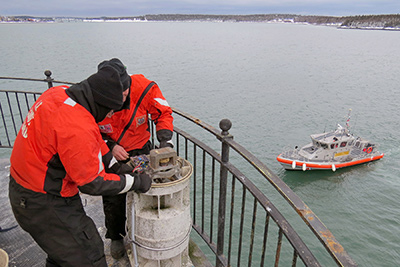
(Photo by Bob Trapani, Jr.)
In order to effectively maintain the number of lighthouses (and minor lights) along the Maine coast, the job calls for diverse skill sets, resources, training and teamwork. In all, five units bear the primary responsibility for maintaining the lights and fog horns in Maine, and includes the Aids to Navigation Teams from Southwest Harbor and South Portland, as well as the 65-foot cutters, SHACKLE (South Portland), TACKLE (Rockland) and BRIDLE (Southwest Harbor).
The boat crews and lighthouse technicians from these units are both dedicated and talented – and they need to be, for both the rocky coast of Maine and the vagaries of the sea can pose quite a challenge to keeping the lights watching properly throughout the year, especially during the winter season.
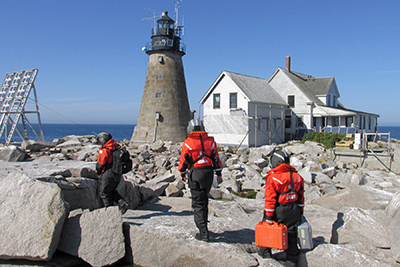
(Photo by Bob Trapani, Jr.)
Many of Maine’s lighthouses are located on remote islands and wave-swept ledges or islets such as Boon Island, Halfway Rock and Whaleback, with a couple of legendary lighthouses – Mount Desert Rock and Matinicus Rock, situated some 20-plus miles out to sea.
Yet the U.S. Coast Guard doesn’t miss a beat. Whether by land, sea or air, Coastguardsmen faithfully service the lighthouses on a regular schedule, which is dictated by the complexity and array of equipment maintained at each light station.
A wide range of equipment and technology is used to ensure that Maine’s lighthouses remain steadfastly effective and efficient. From legacy beacons to cutting-edge light emitting diode technology powered by solar energy, the lights continue to send guiding gleams seaward each and every night.
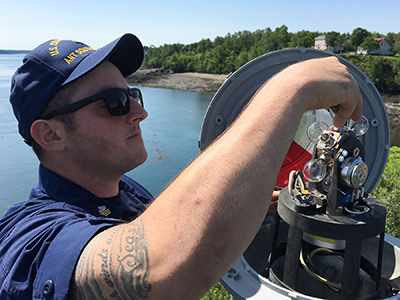
(Photo by Bob Trapani, Jr.)
Even the activation systems for sound signals are keeping pace with modern technology. All of Maine’s fog horns are now outfitted with equipment called the Mariner Radio Activated Sound Signal system, which enables the mariner to activate a fog horn on demand by keying the mic of their VHF radio five times in succession on Channel 83A.
Today most of the lighthouses contain contemporary optics, but some vintage equipment in the form of Fresnel lenses remains in place.
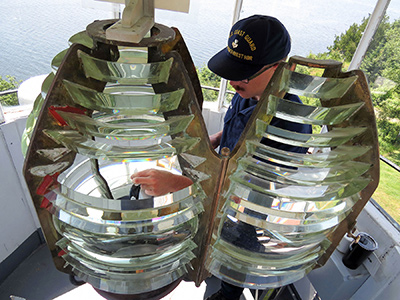
(Photo by Bob Trapani, Jr.)
Did you know that eight Maine lighthouses – West Quoddy Head, Bass Harbor, Fort Point, Browns Head, Owls Head, Pemaquid Point, Seguin Island and Cape Neddick, still have their gorgeous Fresnel lenses? These lenses, which are comprised of intricate glass prisms and brass assemblies, are works of art that date back to the mid-to-late 1800s.
In the end, the public’s fascination with lighthouses is as diverse as people themselves, yet there is one common thread…the universal appreciation for the U.S. Coast Guard’s work as modern day keepers of the lights. Thank you Coast Guard!
This story originally appeared in the September 2019 edition of Maine Lights Today magazine.